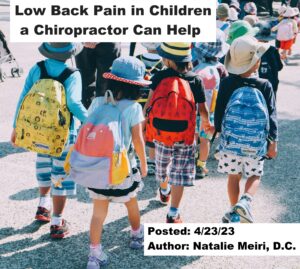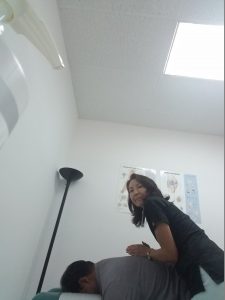
As much as 36% of adolescents (teenagers) will have had low back pain by age 15. But only about 2% will seek treatment. A 25-year research study followed 14-year-old adolescents to age 39. The study found that those with low back pain at age 14 were significantly more likely to have low back pain as an adult. (1)
Certainly the more serious causes of low back pain are tumor or infection. However, the most frequent causes of Low Back Pain in Children a Chiropractor Can Help are either postural, sprain/strain, or spondylolisthesis.
Low Back Pain and the Hyperlordotic Posture in Children
A hyperlordotic posture is also called a hyperlordosis. Visually it may appear as the child having prominent buttocks. It is an excessive curvature of the spine in the lower back. A child’s spine naturally curves in at the lower back (lumbar spine) and out in the mid back part (thoracic spine). For some children, the curve in their lower back is excessive. The hyperlordosis can lead to lower back pain.
Firstly, the hyperlordosis may occur as a result of a disease such as a spondylolisthesis in the lumbosacral spine.
Secondly, it may be due to a hip flexion contracture. The hip flexion contracture could be due to an imbalance of the muscles and/or a chiropractic “subluxation” (joint misalignment/ intersegmental dysfunction) in the hip. For instance, the hip flexor and the paraspinal muscles may be shortened and tight. In contrast, the abdominal muscles may be weakened due to the imbalance. So stretching and strengthening of indicated muscles and adjusting of the anterior superior ilium (part of hip bone) is effective in this case.
Thirdly, the hyperlordosis may be compensatory to a hyperkyphosis (excessive, forward rounding of the upper back in the thoracic region) in the mid back.

Low Back Pain and Sprain/Strain Injuries in Children: Predisposing Factors
A child’s response to injury is often different than an adult. One reason is the weakness of the epiphyseal and apophyseal areas (growth plates in bone). So children are more likely to injure these areas than the attaching ligaments or tendons. Nevertheless, children do sustain sprains (injury to ligament around a joint) and strains (injury to tendon or/and muscle).
During growth spurts, tightness can occur around a child’s joints. And the tightness may predispose the child to overuse injury. Also, the altered alignment of the pelvis, hip, and lower extremity (limbs) happen also predisposing to injuries. In fact, conditions affecting the “ version” (angle of alignment or rotation) of the hips and lower extremity are common. Similarly, differences in leg length due to growth alterations are also common.
Imbalance of muscle strength can also be a predisposition to injury in kids. The most common example is a ratio of quadriceps to hamstring strength. For example in kids the ratio is 2: I versus the adult ratio of 3:2.
Lastly, ligament laxity (looseness) is a predisposition to certain types of injuries. It is especially more common in females such as in a patellar (kneecap) dislocation.

Chiropractic Treatment for Children in West Palm Beach
For Pediatric Chiropractic Care in 2009, a survey found that there were about 68 million pediatric visits to chiropractors. The National Board of Chiropractic Examiners’ most recent practice analysis, issued in 2010, found that about 17 percent of chiropractic patients were under age 18 — approximately 7.7 percent aged five years or younger and some 9.4 percent between ages six and 17. In deed, the American Chiropractic Association cites a study done in 2014 confirming that chiropractic adjustments are overwhelmingly safe in infants and children.
The fact is Chiropractors receive training to adjust all people, from babies to the elderly. Many children have benefited from chiropractic care, including babies.
So conventional (allopathic) medical care is great for saving our lives, but doesn’t do a lot for everyday quality-of-life issues that plague us. Similarly, there’s a lot more anxiety and stress in kids’ lives today. Chiropractic adjustments are great and powerful.
In conclusion, along with adequate nutrition, sleep and physical activity, adjustments can be life changing for children. For parents who are looking for answers besides putting their kids on more drugs, Chiropractic is a great solution.
Meiri Chiropractic in West Palm Beach
Children have the same joints that adults do, but not fully formed yet. They are still developing and adjustments get the spine back in alignment to keep the body balanced and to prevent further problems. Additionally, kids joints are still more cartilaginous than truly bony. Therefore, the adjustments have to be a little bit faster but with less force. This is due to the increased flexibility within the joint and the smaller surface area targeted.
Dr. Natalie Meiri delivers fast adjustments that are low intensity (low force) and low amplitude (low displacement). She also has helped babies and kids utilizing soft tissue techniques, cranial sacral therapy, and homeopathy. Dr. Natalie Meiri has treated babies with ear infections, kids with ADHD, autism, scoliosis, sports injuries and various growing problems. Contact her at 561-253-8984 for further information on Low Back Pain in Children a Chiropractor Can Help or to make an appointment.
References:
(1) Harreby M, Neergaard K, Hesselsoe G, Kjer J Are radiographic changes in the thoracic and lumbar spine of adolescents risk factors for low back pain in adults? Spine.







